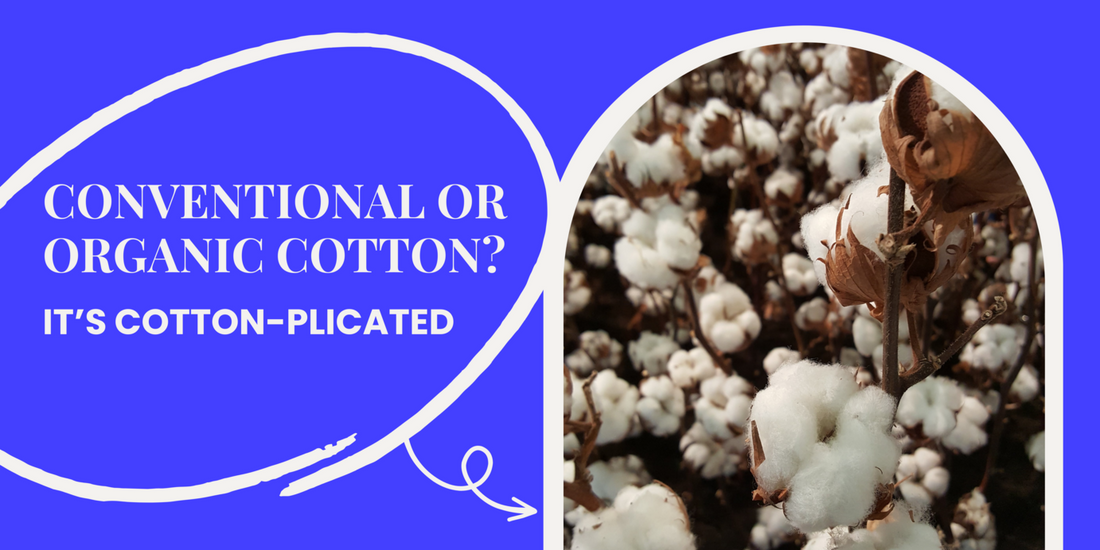
Organic or Conventional Cotton? It’s Cotton-plicated
Teilen
It’s soft, fluffy, and a natural fiber. The cotton plant has clothed humans for millennia and is deeply woven into the fabric of today’s fashion. One cotton plant has even lived a short life on the moon during a Chinese space expedition in 2019! But how does the production of this well-traveled plant impact our own green planet?
Unfortunately, today’s cotton production is interwoven with problems such as water scarcity, pesticides, and poverty wages. Cotton has a substantially larger water footprint than most other plant fibres, and conventional cotton production accounts for 10% of global pesticide use. And although cotton is estimated to provide livelihoods for up to 1 billion people, many farmers are paid very little – not to mention poor wages and working conditions at garment factories.
What about organic cotton?
Efforts to make cotton production more sustainable have resulted in the growth of organic cotton. Organic cotton requires farmers to reduce or eliminate the use of pesticides, synthetic fertilizers, and to use non-GMO cotton seeds.
Overall, this sounds like a win for soils and conscious shoppers – but the climate impact behind organic cotton is more complicated than that. Organic cotton is known to require more water than conventional cotton. This is largely because, unlike organic cotton, conventional cotton has been genetically modified to produce higher yields. Trying to match this yield with organic cotton requires more land use – which also means more water is needed.
So what’s better – conventional or organic cotton?
There is no easy answer to this question. It might be more useful to consider two key factors: rainwater and healthy soil.
-
‘Rainfed’ cotton is the most water-efficient. According to the non-profit research group Cotton Inc, about half of cotton crops globally are rainfed, and this counts for both organic and conventional cotton.
- Healthier soils store water better. When less chemicals and pesticides are used, soils retain more water. However, organic cotton producers are still allowed to use natural or organic pesticides, which may be just as harmful
As you can see, rainfed cotton and healthier soils are not necessarily exclusive to neither conventional nor organic cotton. What really determines the ethics and earth-friendliness of a cotton garment comes down to each farmer’s use of chemicals, irrigation, and labor conditions. Add to this where the cotton was grown, the chemical process of dyeing, and lastly, how far that cotton garment has had to travel before it landed in the shop. Who knew that plain white cotton tee could be so complicated?
Cotton, denim, and the shoes we’re VAERING
As you might know, cotton is woven into denim, and therefore also woven into the fabric of our shoes at VAER! In our little corner of this cotton-complex, we are trying to stretch out the lifetime of these fabrics. We can’t undo the water, chemicals and dye that have already been used in the making of the textiles - but we can do our best to make their climate impact worthwhile.
Denim and cotton often come mixed with either elastane or polyester, because they last longer (and it makes the fabric stretchy). This means that our shoes also combine denim, cotton, and polyester:
While using discarded textiles means that we cannot always pick and choose the most favorable pieces, we still try to find a purpose for any leftover fabric. It’s often pockets, zippers or side stitches that are left to spare, and we try to find a new purpose for each of them. Some scraps can be turned into denim rosettes, and leftover fabrics can be cut into textile yarn which can then be crocheted into new projects. (continued on next page)
Some leftover scraps have also been used in creating a big ‘dreamcatcher’ in collaboration with Tuborgfondet, while others have been used in upcycling projects for Re:wair. Some of the leftover pieces even made it onto the catwalk when VAER participated in Alternative Fashion Week! That’s definitely a lot more glamorous than ending in the trash can, if you ask us. So, while we can’t control the carbon or water footprint of the cotton that comes into our hands, we can do our best to make every thread count.
Written by Kezia Lisby
